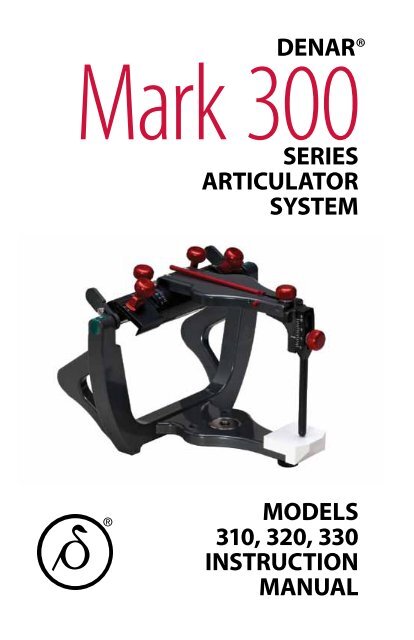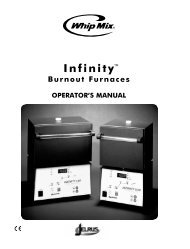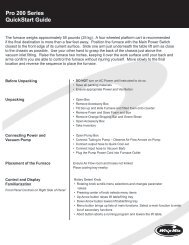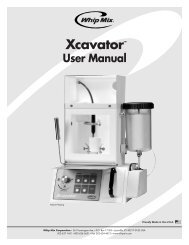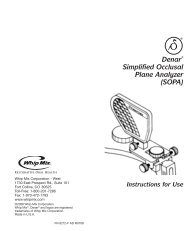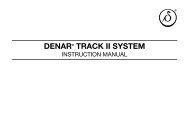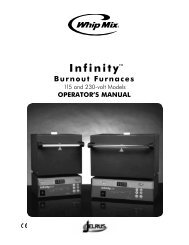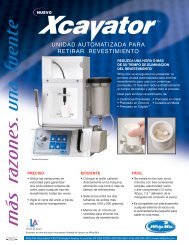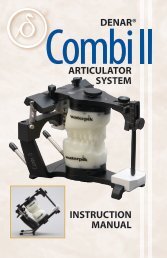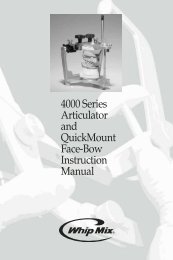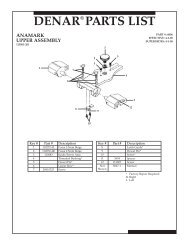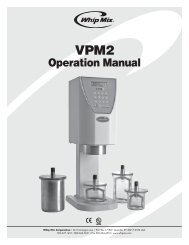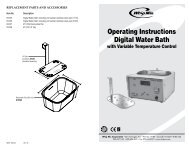denar® articulator system models 310, 320, 330 ... - Whip Mix
denar® articulator system models 310, 320, 330 ... - Whip Mix
denar® articulator system models 310, 320, 330 ... - Whip Mix
Create successful ePaper yourself
Turn your PDF publications into a flip-book with our unique Google optimized e-Paper software.
DENAR®Mark 300SERIESARTICULATORSYSTEMMODELS<strong>310</strong>, <strong>320</strong>, <strong>330</strong>INSTRUCTIONMANUAL
Instruction ManualAcknowledgementsPracticing dentists, technicians, and educators expressed a needfor an easy to use, yet extremely accurate, <strong>articulator</strong> <strong>system</strong>offering interchangeability of articulated casts, intuitive features,and an intelligent ergonomic design.The new Denar® Mark 300 series went through many roundsof laboratory testing to ensure interchangeability within 20microns. Several dentists also spent valuable time putting this<strong>articulator</strong> through excursive movements to ensure highly precisesimulations of the patient’s mandibular motions.Many thanks for the advice and support from current users ofDenar® instrumentation enabling us to develop an articulation<strong>system</strong> based on simplicity, accuracy, and stability.1
Denar Mark 300 Series Articulator SystemTable of contentsAcknowledgements . . . . . . . . . . . . . . . . . . . . . . . . . . . . . . . . . . . . . 1Introduction . . . . . . . . . . . . . . . . . . . . . . . . . . . . . . . . . . . . . . . . . . . . 3Features . . . . . . . . . . . . . . . . . . . . . . . . . . . . . . . . . . . . . . . . . . . . . . . . 4Mark 300 Series Articulator System. . . . . . . . . . . . . . . . . . . . . . . 5Mounting Casts . . . . . . . . . . . . . . . . . . . . . . . . . . . . . . . . . . . . . . . . . 8Accessories . . . . . . . . . . . . . . . . . . . . . . . . . . . . . . . . . . . . . . . . . . . . 10Calibration Procedures . . . . . . . . . . . . . . . . . . . . . . . . . . . . . . . . . 12Care and Maintenance. . . . . . . . . . . . . . . . . . . . . . . . . . . . . . . . . . 12Warranty. . . . . . . . . . . . . . . . . . . . . . . . . . . . . . . . . . . . . . . . . . . . . . . 12Important:Your Denar® Mark 300 Series Articulator is a precisioninstrument manufactured to precise tolerances anddesigned to give you years of trouble-free service. Likeall precision instruments, it must be handled carefullyto avoid damage. When transporting the <strong>articulator</strong>,always remove the upper member from the lowermember and store separately in the instrument case.2
Instruction ManualintroductionWho Should Use the Denar® Mark 300 SystemDoctors Who Want:• To mount casts quickly and easily on a semi-adjustable instrumentthat accurately reproduces mandibular movements.• Confidence in creating repeatable movements when casts aremounted on another Mark 300 Series <strong>articulator</strong>.• A complete <strong>system</strong> for determining the maximum accuracy offit in developing well-functioning restorations.• To produce restorations by means of checkbite records and/orthe functionally generated path (FGP) techniques.• A semi-adjustable <strong>articulator</strong> with adjustment capabilities forprotrusive condylar inclination, progressive side shift, andimmediate side shift.• Casts mounted on a very rigid <strong>articulator</strong> in the position ofmaximum intercuspation.Technicians Who Want:• A practical, rigid, and easy to use <strong>articulator</strong>.• To efficiently produce restorations that require fewer remakes.• To receive mounted casts.• Quality workmanship providing tightened tolerances anddurable finishes.• Ability to accurately replicate patient movements.Educators Who Want:• An economically priced <strong>articulator</strong> and facebow for studentissue without violating sound anatomical principles.• Occlusal instruments that fulfill the needs of all restorativedepartments.• To avoid the need for the student to have a separate <strong>articulator</strong>for each restoration under construction.Students Who Want:• To study Occlusion and the movement of the temporomandibularjoint.• An instrument with intelligent modular design and ergonomicfeatures.3
Denar Mark 300 Series Articulator SystemThe new Denar® Mark 300Articulator System Features:Protrusive Condylar Inclination:Model <strong>330</strong> Model <strong>320</strong> adjustable 0 – 60 degrees,Model <strong>310</strong> fixed at 25 degrees.Progressive Side Shift:Model <strong>330</strong> adjustable 0 – 15 degreesModel <strong>320</strong> Model <strong>310</strong> fixed at 15 degrees.Immediate Side Shift:Model <strong>330</strong> adjustable 0 – 2 mm.Model <strong>320</strong> Model <strong>310</strong> fixed.Elastic Retainers hold upperand lower members togetherand assist in smoothoperation of lateralexcursions.Positive centric latch allows theupper and lower members to beseparated or positivelylocked together in centricrelation in both open andclosed positions.Stable in 3 positions.Built-in magneticmounting <strong>system</strong>.Durable anodized finish on allmechanical parts.Easy to clean powder coatingon all mounting surfaces.All adjustments secured byfinger screws;no tools needed.Model <strong>330</strong>Model <strong>320</strong>Model <strong>310</strong>4
Instruction Manualmark 300 <strong>articulator</strong> <strong>system</strong>Articulator ManipulationsTo attach the incisal pin, thread thetop thumbscrew into the opening onthe front of the upper member until itslides back as far as it will go. Tightenthe top thumbscrew (figure 1).To assemble the <strong>articulator</strong>, hold theupper member approximately parallelto the lower member and simply placeit on the lower member.IMPORTANT: We recommend usingthe incisal pin to put the <strong>articulator</strong>through excursive movements ratherthan the casts. Pushing on the castsmay affect accuracy.Centric Latch OperationWhen the <strong>articulator</strong> is closed it canbe locked in the centric position bypushing the centric latch to the downposition (figure 2).Support PinThe built in support pin allows the uppermember of the <strong>articulator</strong> to standcompletely open while the <strong>articulator</strong>is setting flat (figure 3). To ensurethe support pin remains in position,use the red lock pin to hold the liftedsupport pin in place. With the <strong>articulator</strong>facing you, lift the support pin andpush the lock pin to the right (blacko-ring exposed) to lock in place (figure4). To lower the support pin, first pushthe lock pin to the left.Fig. 1Fig. 2Fig. 3Fig. 45
Denar Mark 300 Series Articulator SystemFig. 5Articulator AdjustmentsThe <strong>articulator</strong> is a mechanical equivalent ofthe lower half of the head – a mechanical jawso to speak. In order to discuss the adjustmentsof the <strong>articulator</strong> or specifically thefossa controls, it would be helpful to discussthe condylar paths of movement of the humanmandible. In a lateral mandibular movementthe condyle on the side toward whichthe mandible moves is termed the rotatingcondyle (figure 5). The condyle on the side oppositethe side towards which the mandiblemoves is termed the orbiting condyle.In a lateral mandibular movement the orbiting condyle movesinward, downward and forward and orbits about the rotating condylewhich is simultaneously rotating and moving outward duringthe lateral mandibular movement.• Orbiting path – the path of movement of the orbiting condyle.• Rotating path – the path of movement of the rotating condyle.• Protrusive path – the path of movement of the condyles in astraight protrusive movement.The Mark 300 System has been designed for simplicity andefficiency. The different Models allow different levels ofadjustment and enable Clinicians to choose based on their needs.Model <strong>330</strong> incorporates a complete range of adjustments:Protrusive Condylar Inclination, Immediate Side Shift and ProgressiveSide Shift.Model <strong>320</strong> allows Protrusive adjustment but Progressive SideShift is fixed at 15˚ thus eliminating any chance of balancing sideocclusal contact.Model <strong>310</strong> incorporates anatomical averages based on clinicalresearch. Protrusive movement is fixed at 25˚ and Progressive SideShift is fixed at 15˚. The angles were selected as offering the leastamount of interference, based on studies by Dr. Harry Lundeenand Dr. Carl Wirth.6
Instruction ManualProtrusive AdjustmentsProtrusive Condylar Inclination: the angleof the fossa in relation to the occlusalplane.Model <strong>330</strong> Model <strong>320</strong> The inclinationof the protrusive condylar path can beadjusted by loosening the protrusiveadjustment thumbscrew. The protrusivecondylar path inclination scale is belowthe protrusive adjustment thumbscrewand is calibrated in increments of 5degrees (figure 6). The protrusive adjustment range is 0 – 60degrees.Fig. 6Immediate Side Shift AdjustmentImmediate Side Shift: a mandibular sideshift in which the orbiting condyle movesessentially straight medially as it leavescentric relation.Model <strong>330</strong> The medial fossa wall canbe displaced straight medially by meansof the immediate side shift adjustment.The scale for the immediate side shiftadjustment is lateral to the protrusiveadjustment thumbscrew on top of thefossa. The scale is calibrated in 0.5 millimeterincrements on the upper scaleand 1 millimeter increments on the lowerscale. Figure 7a shows an immediate sideshift of 0 mm. To set the immediate sideshift, loosen the thumbscrew below thescale and align the marks of the lowerscale with either the long mark of the upper scale for shifts of 1 or2 mm, or with the smaller marks for shifts of 0.5 or 1.5 mm. Figure7b shows an immediate side shift setting of 1.5 mm. The immediateside shift range is 0 – 2 mm.Once you have set the immediate side shift, tighten down on thethumbscrew. This will hold immediate side shift in place as youuse the Bennett lever to adjust progressive side shift.Fig. 7aFig. 7b7
Denar Mark 300 Series Articulator SystemProgressive Side Shift AdjustmentProgressive Side Shift: the path the orbiting condylefollows on the medial wall of the fossa as itorbits around the rotating condyle.Fig. 8Fig. 9Fig. 10Model <strong>330</strong> The angle of inclination of themedial fossa wall to the sagittal plane can be adjustedby moving the progressive side shift Bennettlever from 0 to 15 degrees. The scale for theprogressive side shift adjustment is beside theadjustment thumbscrew and is calibrated in 5degree increments (figure 8). Once immediateand progressive side shift are set, tighten thethumbscrew to ensure the settings stay as needed.Mounting a cast on the Mark 300 SeriesIn addition to a facebow recording (figure 9) the only recordsneeded for complete programming of the Mark 300 Series are:a lateral bite recorda centric relation bite recorda protrusive bite recordIf anterior teeth are to be restored, a customizedanterior guidance table is fabricated toprecisely copy the desired guidance.The Slidematic facebow is used to recordcondylar axis (figure 9).The upper cast is related to the condylar axis.The index for the facebow fork corrects theposition of the cast to relate it to the condylaraxis instead of the ear holes. This is an automaticcorrection (figure 10).Make sure that mounting plate divotsare clean of all dust, dirt or other debrisbefore mounting casts.NOTE: To enhance accuracy, the mountingplates have been designed so that they donot fit perfectly flat against the <strong>articulator</strong>member. You may notice a slight gap.8
Instruction ManualA centric relation bite record is made(figure 11).Fig. 11The lower cast is related to the uppercast by alignment into the centric relationrecord (figure 12).Fig. 12The completed mounting permitsclosure of the casts to contact in centricrelation (figure 13).Fig. 13IMPORTANT: We recommendusing the incisal pin to put the<strong>articulator</strong> through excursivemovements rather than thecasts. Pushing on the casts mayaffect accuracy.9
Denar Mark 300 Series Articulator SystemAccessoriesDenar® Slidematic FacebowThe time-saving design of this device eliminatesthe need for transferring the entire facebow tothe <strong>articulator</strong>. It is a fast, easy and accurate meansof transferring the proper maxillary relationships.Transfer only the transfer jig assembly to the <strong>articulator</strong>thus freeing the measuring bow to be used forthe next patient.Simplified Occlusal Plane AnalyzerDesigned for analyzing the Curve of Spee and theCurve of Wilson.Occlusa-Check®Used for the detection of occlusal interferences ofrestorations while they are still on the <strong>articulator</strong>.When the pin locks into the slot, the restorationis the correct height. If the restoration is built toohigh, the pin will not go into the slot.10
Instruction ManualAccessoriesMaxillary Cast SupportThe adjustable “T” supports the bitefork andmaxillary cast when mounting the facebowrecord on the <strong>articulator</strong>. Works with bothmagnetic and traditional plates.Item 003401-000.Mark 300 Magnetic Mounting SystemProvides magnetic retention without addingsteps to the process, casts are mounted inone quick step. Compatible with Denar®Mark 300 Series only.Denar® Pins and TablesAll Denar® incisal pins and tables are interchangeable between<strong>articulator</strong>s. Incisal pins can be raised and lowered on an arc,simulating the natural arc of closure. The pins and tables must beused in the combinations listed.P2T2: Long Centric/Adjustable foot and Custom Platform, step.P2T3: Long Centric/Adjustable foot and Adjustable table.P4T4: Short Round with support or Short Round Black withsupport and Custom Platform, flat.P6T6: Tapered and Adjustable.Dawson Fossa Guide Pin and Custom Platform, flat.Anterior Determiner and Custom Platform, flat.11
Denar Mark 300 Series Articulator SystemCalibration ProceduresAll Mark 300 Series <strong>articulator</strong>s are calibrated at the factory. If you would liketo have your <strong>articulator</strong> recalibrated, please call 800-626-5651 for a returnauthorization number.Care and MaintenanceYour <strong>Whip</strong> <strong>Mix</strong> <strong>articulator</strong> is a precision instrument and requires care andmaintenance. Periodic cleaning and lubricating as described below will assureprolonged life and dependable service from the instrument. Failure to followthese instructions will void your warranty.CleaningUse a mild soap and water solution with a very soft brush to dissolve accumulationsof wax and to wash away carborundum grit. Then air dry and lubricate.DO NOT use strong detergents, alkalies, gasoline or naphtha as cleaningagents!StorageStore the <strong>articulator</strong> in a clean, dry atmosphere free of plaster and carborundumdust, away from acids, alkalies or corrosive medicaments. Wait a full dayafter mounting casts before storing the <strong>articulator</strong> in a carrying case orcorrugated carton. Moisture dissipation from the stone in an enclosed areacauses alkalinity of the stone mixture which can damage the <strong>articulator</strong>surface.Warranty<strong>Whip</strong> <strong>Mix</strong> Corporation warrants the <strong>articulator</strong> <strong>system</strong> to be free from defectsin material and/or workmanship for a period of one year. In the event of adefect, please notify the factory in writing prior to returning the instrument.<strong>Whip</strong> <strong>Mix</strong> Corporation will, at its option, either repair, replace or issue creditfor such defects.Because <strong>Whip</strong> <strong>Mix</strong> Corporation is continually advancing the design and manufacturingmethod of its products, it reserves the right to improve, modify ordiscontinue products at any time, or to change specifications or prices withoutnotice and without incurring obligations.12
Instruction Manual13
<strong>Whip</strong> <strong>Mix</strong> Corporation361 Farmington AvenueLouisville, KY USA 40209Toll-Free: 800-626-5651Phone: 502-637-1451Fax: 502-634-4512www.whipmix.com<strong>Whip</strong> <strong>Mix</strong>®, Denar® and logos are registered trademarksof <strong>Whip</strong> <strong>Mix</strong> Corporation. ©2008 <strong>Whip</strong> <strong>Mix</strong> Corporation.FN 20011575-F AC R1010


